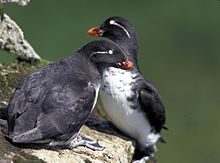Parakeet auklet
| Parakeet auklet | |
|---|---|

| |
| Scientific classification | |
| Domain: | Eukaryota |
| Kingdom: | Animalia |
| Phylum: | Chordata |
| Class: | Aves |
| Order: | Charadriiformes |
| Family: | Alcidae |
| Genus: | Aethia |
| Species: | A. psittacula
|
| Binomial name | |
| Aethia psittacula (Pallas, 1769)
| |

| |
| Synonyms | |
|
Cyclorrhynchus psittacula[2] | |
The parakeet auklet (Aethia psittacula) is a small seabird of the North Pacific. Parakeet Auklets used to be placed on its own in the genus Cyclorrhynchus (Kaup, 1829) but recent morphological and genetic evidence suggest it should be placed in the genus Aethia, making them closely related to crested auklets and least auklets. It is associated with the boreal waters of Alaska, Kamchatka and Siberia. It breeds on the cliffs, slopes and boulder fields of offshore islands, generally moving south during the winter.
Description[edit]
The parakeet auklet is a small (23 cm) auk with a short orange bill that is upturned to give the bird its curious fixed expression. The upward bend of the beak has been observed to provide advantages in picking up small food pieces from the sea bottom as well as in assisting in the disintegration of larger food objects.[3] The bird's plumage is dark above and white below. with a single white plume projecting back from the eye. There is a small amount of variation between breeding and winter plumage.
The parakeet auklet is a highly vocal species at the nest, calling once it arrives at the nest and then duetting once its mate arrives. It makes a series of rhythmic hoarse calls (like that of the Cassin's auklet) and a quavering squeal. The function of these are unknown, but could be associated with defending its burrow from intruders and strengthening the bond with its mate.
Taxonomy[edit]
The Parakeet Auklet was formerly included in the genus Cyclorrhynchus, avians with a nearly circular profile of the bill. But following recent phylogenetic study, this species could be closer to the Crested Auklet, Least Auklet and Whiskered Auklet.[citation needed]
Behaviour and breeding[edit]

The parakeet auklet's food varies with season, during the breeding season it takes mostly small planktonic crustaceans such as euphausiids, copepods and amphipods. Recent research shows it also preys on jellyfish in some areas. It often feeds at a considerable distance from the colony, diving up to 30 m to reach its prey.
Breeding begins in April and May in colonies that are often shared with other auk species. The pair lay one egg, which is incubated for just over a month, the chick is then fed 4 times a day for around 35 days. The chick fledges at night, flying out to sea alone.
Relationship with humans[edit]
The parakeet auklet has little contact with humans despite its large population, this is largely due to their remote breeding and wintering. However, the parakeet auklet still faces issues caused by marine pollution and ingestion of small plastics.[citation needed]
Status and conservation[edit]

The parakeet auklet is not considered threatened, there are estimated to be over a million individuals in the North Pacific. It is not thought to have declined recently, but may be threatened in the future by introduced predators and oil spills.
References[edit]
- ^ BirdLife International (2020). "Aethia psittacula". IUCN Red List of Threatened Species. 2020: e.T22694906A168849515. doi:10.2305/IUCN.UK.2020-3.RLTS.T22694906A168849515.en. Retrieved 13 November 2021.
- ^ Gaston, A.J. and Jones, I.L. 1998. The Auks: Alcidae. Bird Families of the World. Oxford University Press, 349pp.
- ^ Badikova, A. A.; Dzerzhinsky, F. Ya.; Kuznetsov, A. N. (2019-12-01). "Functional Morphology and Adaptive Significance of the Jaw Apparatus of the Parakeet Auklet (Aethia psittacula, Alcidae)". Biology Bulletin. 46 (7): 666–678. doi:10.1134/S1062359019070021. ISSN 1608-3059. S2CID 211218208.
- Collinson, Martin. 2006. Splitting headaches? Recent taxonomic changes affecting the British and Western Palaearctic lists British Birds 99: 306-323.
- del Hoyo, J., Elliott, A. and Ssargatal, J. (eds.) 1996 Handbook of the Birds of the World, Vol. 3: Hoatzin to Auks. Lynx Edicions: Barcelona, Spain. ISBN 84-87334-20-2
- Harrison, P.. 1983. Seabirds, an Identification Guide. Houghton Mufflin Co.: Boston, USA. 448pp. ISBN 0-7470-1410-8
- "National Geographic" Field Guide to the Birds of North America ISBN 0-7922-6877-6
- Sibley, D.A. 2001. The Sibley Guide to Birds. Alfred Knopf: New York, USA. ISBN 0-679-45122-6
- "Aethia psittacula". Integrated Taxonomic Information System. Retrieved 24 February 2009.
External links[edit]
- Parakeet auklet images http://tsuru-bird.net/image.htm Copyright 2009 - Monte M. Taylor

